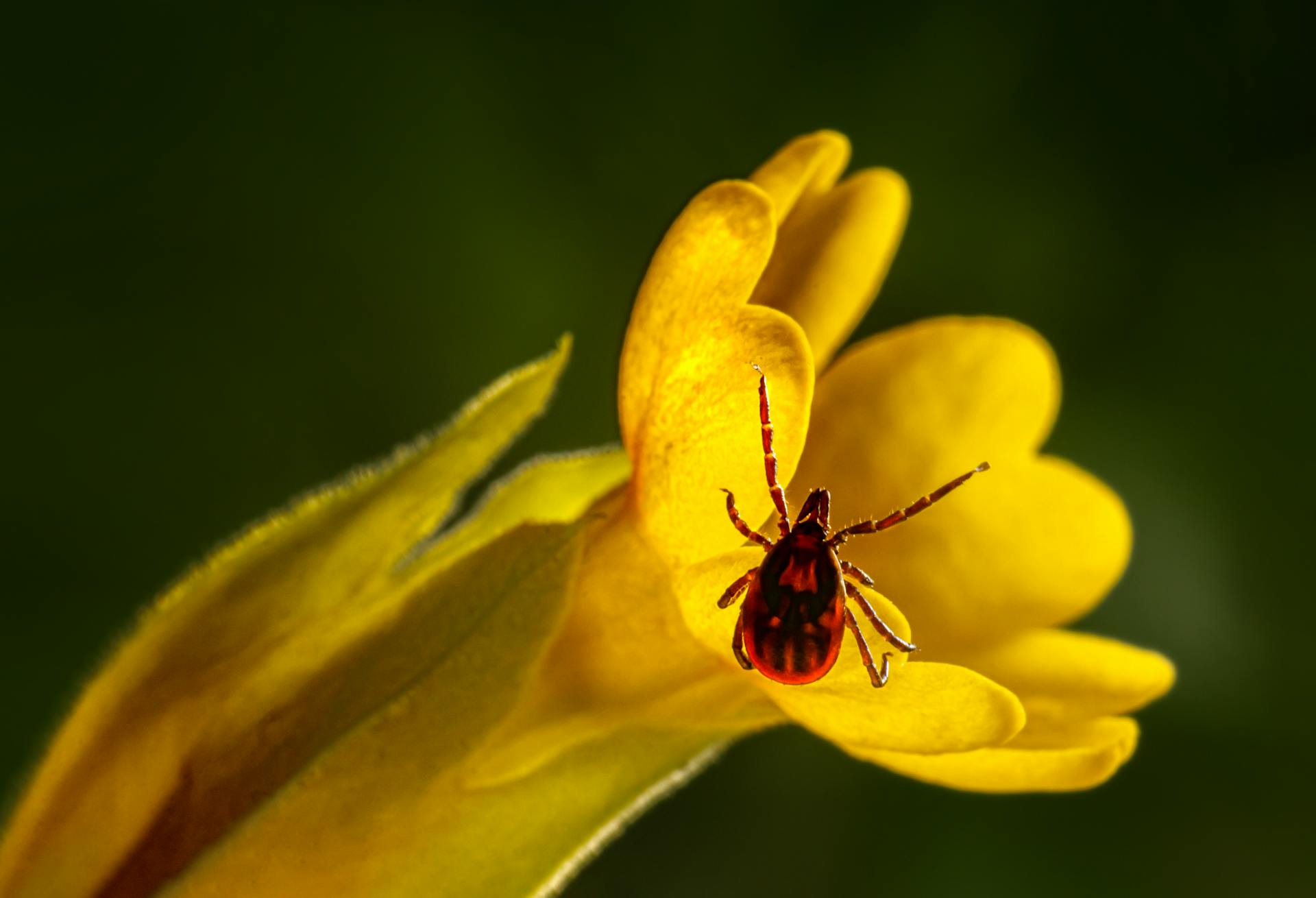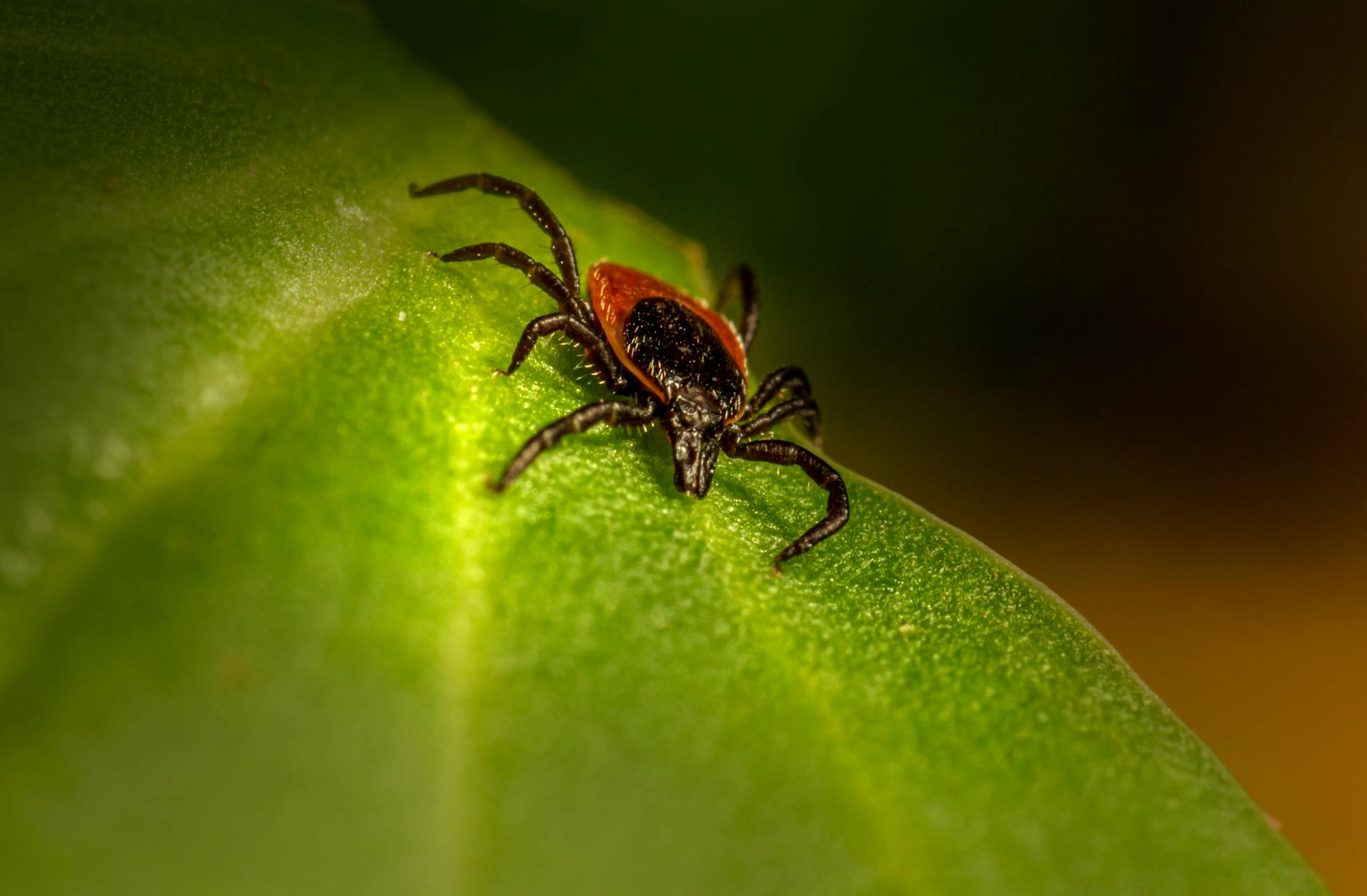
American dog ticks can transmit several diseases to humans, including Rocky Mountain spotted fever, which can cause fever, headache, and a distinctive rash.
This disease is caused by the bacterium Rickettsia rickettsii and can be fatal if left untreated.
Symptoms of Rocky Mountain spotted fever typically appear within 2-14 days after being bitten by an infected tick.
In addition to Rocky Mountain spotted fever, American dog ticks can also transmit ehrlichiosis, a disease caused by the bacterium Ehrlichia chaffeensis.
Ehrlichiosis can cause fever, headache, and muscle pain, as well as a decrease in the number of white blood cells, which can make it harder for the body to fight off infections.
If left untreated, ehrlichiosis can lead to more serious complications, such as kidney or liver failure.
Broaden your view: Lyme Disease
Tick-borne Diseases
Tick-borne diseases are a serious concern for both humans and dogs. Many of these pathogens are zoonotic, meaning they can infect humans as well as dogs.
Take a look at this: Can a Dog Flea Live on a Human
The most common tick-borne diseases are Ehrlichiosis, Anaplasmosis, Rocky Mountain spotted fever, Hepatozoonosis, Babesiosis, and Lyme disease. These diseases are caused by bacteria, parasites, or viruses transmitted through tick bites.
Tick-borne diseases can be transmitted within a relatively short period of time, ranging from 3-6 hours for Ehrlichiosis and Rocky Mountain spotted fever-causing bacteria to 24-48 hours for Lyme Disease-causing bacterial transmission.
Here are some common symptoms of tick-borne diseases in humans and dogs:
- Depression and/or lack of energy
- Loss of appetite
- Runny eyes and nose/discharge
- Spontaneous nose bleeds
- Bruising on gums and belly
- Lameness/joint pain
- Spontaneous and shifting leg lameness
- Reluctance to move
- Fever
- Bruising or nose bleeds
- Poor appetite
- Swollen lymph nodes
- Low platelet levels
- Jaundice (orange or yellow-colored skin or whites of eyes)
- Dark-colored urine
- Pale gums
- Lethargy
- Vomiting and weakness
It's essential to monitor tick-borne disease prevalence in your region, as it can fluctuate depending on weather, rainfall, and climate.
Tick-borne Disease Prevalence
Ehrlichiosis is most commonly reported in the southwestern and Gulf Coast regions of the United States, with the highest concentration of Ehrlichia canis cases.
The lone star tick and brown dog tick are the primary vectors of Ehrlichia species, and their distribution is on the rise in states as far north as Massachusetts and as far west as central Oklahoma and Kansas.
Ehrlichiosis is caused by Ehrlichia species of bacteria, which infect white blood cells and platelets, leading to symptoms such as depression, loss of appetite, and spontaneous nose bleeds.
Rickettsial diseases, including canine anaplasmosis and Rocky Mountain Spotted Fever, are also prevalent in the United States and Canada, with the American dog tick and lone star tick being primary vectors.
The distribution of tick-borne disease is associated with the species of tick endemic to a given region, and it's not stable and fluctuates on a seasonal basis depending on weather, rainfall, and climate.
Here's a summary of the tick-borne diseases mentioned:
- Ehrlichiosis: caused by Ehrlichia species of bacteria, transmitted by the lone star tick and brown dog tick
- Canine anaplasmosis: caused by Rickettsia species of bacteria, transmitted by the lone star tick and other ticks
- Rocky Mountain Spotted Fever: caused by Rickettsia rickettsii bacteria, transmitted by the American dog tick and lone star tick
Tick Species
There are many species of ticks found around the world, and each has its unique characteristics. Some of the most common tick species include the American Dog, Asian Longhorn, and Blacklegged Deer ticks.
The Asian Longhorn tick, for example, is known for its distinctive long horns and is a common problem in certain regions.
Some other notable tick species include the Brown Dog, Cayenne, and Groundhog ticks.
The Brown Dog tick is known for its brown color and is often found in areas with high humidity.
Here's a list of some of the most common tick species:
- Common Ticks
- American Dog
- Asian Longhorn
- Blacklegged Deer
- Brown Dog
- Cayenne
- Groundhog
- Gulf Coast
- Lone Star
- Pacific Coast
- Rocky Mt. Wood Tick
- Western Deer
- Soft Bodied Ticks (Argasidae)
Prevalence and Testing
The prevalence of tick-borne diseases in humans can be quite alarming, with many cases going unreported.
Tick-borne diseases are associated with the species of tick endemic to a given region, and their distribution is not stable, fluctuating on a seasonal basis depending on weather, rainfall, and climate.
Monitoring of tick-borne diseases is a dynamic, ongoing process due to these fluctuations.
The actual number of dogs infected by ticks is likely many times higher than reported figures, since so many dogs go untested for tick-borne diseases.
Here are some common tick-borne diseases in humans:
- Ehrlichiosis
- Lyme disease
- Anaplasmosis
- Heartworm disease
Prevention and Identification
Preventing your dog from contracting a tick-borne disease should be a top priority. Always remember that no method is 100% effective, so carefully consider outings and apply tick control treatments before taking your dog to environments where ticks may thrive.
Tick season lasts through spring, summer, and fall, and is a year-round issue in warmer climates. They are typically dark brown or black in color, and can transmit diseases within 3 to 6 hours of biting your pup.
If you discover a tick, quickly remove it to prevent infection. Consider bringing your dog to a vet, who will be able to remove it safely.
Preventing Dog Diseases
Preventing tick-borne diseases should be a top priority for dog owners. Always check your dog and yourself for ticks when you arrive home from outings.
Carefully consider your dog's outings and apply tick control treatments before heading to areas where ticks thrive. No method is 100% effective, so vigilance is key.
Tick season lasts through spring, summer, and fall, and is a year-round issue in warmer climates. Ticks are typically dark brown or black in color.
Quickly remove any discovered ticks to prevent infection. Consider bringing your dog to a vet for safe removal.
Tick Identification
Ticks are often mistaken for other small insects, but they have a distinctive oval shape with eight legs.
They can be as small as 1/8 inch in diameter, making them difficult to spot.
Their color varies from brown to gray to black, depending on the species.
Some ticks can be as large as 1/2 inch in diameter.
Ticks have a hard outer shell called a carapace that protects their soft body.
There are over 900 species of ticks, but only a few are known to transmit diseases to humans.
The most common tick species in the US is the blacklegged tick.
Ticks are often found in wooded areas, grasslands, and near bodies of water.
They can also be found in urban areas, especially in areas with high vegetation.
Ticks are most active during warm and humid weather.
They can survive for up to a year without feeding, but typically feed every 1-3 days.
Ticks can attach to humans and animals for up to 10 days before dropping off.
It's essential to check yourself thoroughly after spending time outdoors, especially in areas where ticks are common.
Related reading: Dog Flea Bites on Human
Life Cycle and Seasonality
The American dog tick's life cycle is a complex process that involves multiple hosts and stages. It takes at least 54 days to complete, but can take up to two years depending on host availability, location, and temperature.
A female American dog tick will drop from its host after five to 14 days of blood feeding, and then lay anywhere from 4,000 to 6,500 eggs on the ground. This usually happens after she has digested her blood meal and developed her egg clutch over four to 10 days.
The tick's life cycle requires three different hosts, and the entire process can be influenced by factors like temperature and host availability. For example, larvae can survive up to 11 months without feeding, while nymphs can survive six months without a blood meal.
Life Cycle
The life cycle of the American dog tick is a complex and fascinating process. It requires a blood meal before progression from larva to nymph, from nymph to adult, and by the adult for egg production.

It takes at least 54 days to complete the cycle, but can take up to two years depending on host availability, location, and temperature. The cycle requires three different hosts.
After feeding, a fully engorged female tick drops from the host and digests the blood meal over the next four to 10 days. She then lays anywhere from 4,000 to 6,500 eggs on the ground.
Larvae can survive up to 11 months without feeding and wait for small mammals to serve as hosts for their first blood meal. This behavior is called questing.
After feeding, larvae detach from their host and fall to the ground where they digest their blood meal and molt into the nymphal stage. This process can take as little as a week, although it's often prolonged.
Adults can survive two years without feeding, but readily feed on dogs or other larger animals when available. Questing adult ticks climb onto a grass blade or other low vegetation and wave their legs as a potential host approaches.
Seasonality
Adult American dog ticks overwinter in the soil and are most active from around mid-April to early September. This is a general trend observed in various regions.
In northern areas, such as Massachusetts and Nova Scotia, adults appear from April to August with a peak in May and June. In these regions, the tick activity is relatively short-lived.
In central latitudes of the U.S., such as Virginia, adults are found to be active from April to September/October with peaks in May and July. This longer activity period is likely due to the warmer climate.
A study in Lexington, Kentucky found that the duration of D. variabilis' spring activity was related to its overwintering success. This means that the ticks that survive the winter months are more likely to be active during the spring.
In Georgia, adult ticks are active from late March to August with peaks from early May to late June. This is a bit earlier than in some other regions, possibly due to the warmer climate.
In Florida, adult D. variabilis activity occurs from April to July. This is a relatively short activity period, likely due to the hot and humid climate.
Medical Importance
American dog ticks are a significant threat to human health, and it's essential to understand the risks they pose.
Rocky Mountain Spotted Fever is a serious tick-borne illness that can be fatal if left untreated, with a mortality rate of over 20% if not treated promptly.
Symptoms of this disease include high fever, chills, muscle aches, headaches, and a rash that spreads across the extremities 2-4 days after the fever begins.
The tick must be attached for six to eight hours for transmission to occur, and in some cases, transmission requires more than 24 hours.
Tularemia is another disease transmitted by American dog ticks, which can be spread from rabbits, mice, squirrels, and other small animals.
Symptoms of Tularemia include an ulcer at the bite site, fever, chills, and tender lymph nodes.
Consider reading: Lifespan of Dog with Kidney Disease
Frequently Asked Questions
What to do if you find an American dog tick on you?
Remove the tick by grasping it with fine-tipped tweezers as close to your skin as possible and pull upwards with steady, even pressure. After removal, wash the affected area and your hands with soap and water
Sources
- https://www.akcchf.org/canine-health/sporting-field-dogs/tick-borne-disease.html
- https://www.westportveterinary.com/site/blog-westport-vet/2021/01/11/tick-borne-diseases-dogs
- https://entnemdept.ufl.edu/creatures/urban/medical/american_dog_tick.htm
- https://www.pestworld.org/pest-guide/ticks/american-dog-ticks/
- https://ticksafety.com/tick-identification/american-dog-tick/
Featured Images: pexels.com


